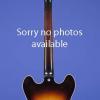"Eric with a Factory Bigsby"
Weighs 9.10 lbs. and has a nut width of just over 1 5/8 inches and a standard Gibson scale length of 24 3/4 inches. Single-bound laminated maple body, one-piece mahogany neck, and rosewood fretboard with 22 frets and inlaid pearl block position markers. Individual Kluson Deluxe tuners with double-ring Keystone plastic buttons. Headstock with inlaid pearl "Gibson" logo and pearl crown inlay. Two humbuckers with balanced outputs of 7.31k and 7.46k. Five-layer (black/white/black/white/black) plastic pickguard. Four controls (two volume, two tone) plus three-way selector switch. Black plastic bell-shaped knobs with metal tops. ABR-1 Tune-O-Matic retainer bridge with nylon saddles and factory Bigsby vibrato tailpiece. With "Custom Made" plaque covering the two factory stud tailpiece holes. A very small amount of playing wear to the back of the neck, a few tiny marks on the back and on the headstock. An excellent and totally original example, with all nickel parts, very similar (except for the factory Bigsby) to the guitar that Eric Clapton used in his "Yardbirds" and early "Cream" days. That particular guitar (serial number "67473") fetched a huge $847,500 at the recent auction of his guitars at Christie's New York (Lot 41). Housed in its original Gibson black hardshell case with red plush lining. This guitar (serial number "66513") is one of 892 "Cherry Red" ES-335s shipped in 1964, out of a total of 2,750 shipped between 1960 and 1964 ("Natural" was discontinued as an optional finish in 1960 and replaced by "Cherry Red").
"Introduced in 1958, the ES-335T (originally no final D) truly ranks among the all-time Gibson classics, not only because of its enduring popularity but also because of its semi-solid construction which pioneered a new style of electrics" (A.R. Duchossoir, Gibson Electrics -- The Classic Years, p. 231).
"There were indeed a number of firsts in the early days of the electric guitar, but in retrospect only few of them can be considered as true milestones. The double cutaway thinline pioneered by Gibson in 1958 genuinely rank amongst the great original designs. Their graceful shape was truly innovative at the time and spawned several imitations such as Gretsch's revamped Chet Atkins series or the Guild Starfire. But perhaps the most important hallmark of the new thinline was their semi-solid construction. Indeed Gibson's prime objective was to design an instrument that would combine the advantages of both solid and hollow body electrics and therefore appeal to a variety of players, regardless of their musical style" (A.R. Duchossoir, Gibson Electrics -- The Classic Years, p. 77).
Translate:

